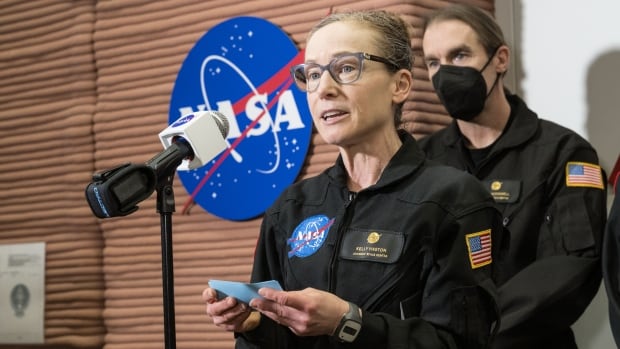When Kelly Haston emerged from NASA’s yearlong Mars simulation project, she was met with flashing cameras, beaming colleagues and rigorous applause.
It was a stark change from the previous 378 days, during which she saw nobody but her three crew members, all sharing a quiet, 157-square-metre habitat at the Johnson Space Center in Houston meant to simulate an eventual mission to the red planet.
“The stimuli is overwhelming, because we have been in that habitat for a long time, and we’re very used to our routine and each other,” said Haston, a research scientist and member of the Mohawk Nation of the Six Nations of the Grand River in Ontario.
“But to be honest, I was very ready.”
As she peered into the crowd gathered for a post-mission press conference, Haston spotted her family waiting for her, and she smiled from ear to ear.
“It was … a joyful moment,” she told As It Happens host Nil Köksal.
Work-life balance in fake space
Haston was the mission commander for NASA’s all-volunteer Crew Health and Performance Exploration Analog (CHAPEA) project, the first of three planned yearlong Mars simulations.
She and her colleagues Ross Brockwell, Nathan Jones and Anca Selariu entered the Mars environment on June 25, 2023, and emerged to much fanfare on July 6.
While living in the 3D-printed environment, called Mars Dune Alpha, the team went through the motions of what daily life on Mars might look like.
Canadian research scientist Kelly Haston shares what it was like spending more than 12 months with three crewmates inside a 157-square-metre habitat designed by NASA to simulate an eventual mission to Mars.
That meant suiting up and going on simulated “Marswalks,” growing and harvesting veggies to supplement their diet, gathering data about their own health, maintaining their habitat and their equipment, and generally getting by every day on limited resources, isolation and delays in communication of up to 22 minutes with anyone on the outside.
The whole thing made for an odd work-life balance, says Haston.
“You are rolling out of your room and you are at work,” she said. “Every day I would get up, and pretty much as soon as I’m moving, I’m weighing myself, I’m starting to take data about my personal health or how I’m doing.”

But in other ways, she says, it didn’t feel like work at all.
The crew played board games and table tennis, threw each other birthday parties, gave each other haircuts, celebrated holidays together and sat down every day to share meals — made, in part, from ingredients they’d grown as a team.
“The crew felt like home, because we bonded and became a unit,” Haston said. “Like an odd family unit.”
That odd family included Jones, a physician and the crew’s medical officer, who said in a NASA press release that the journey taught him to slow down, live in the present, and explore his creativity through drawing.
“I learned to take time to enjoy the current season and be patient for the coming ones,” he said. “I have even surprised myself with how well some of my sketches have turned out.”

Brockwell, who served as the mission’s flight engineer, says the experience taught him the importance of living sustainably for the benefit of everyone on Earth.
“I’m grateful for the chance to live the idea that we must utilize resources no faster than they can be replenished, and produce waste no faster than they can be processed back into resources,” Brockwell said during the post-mission press conference.
And Selariu, a microbiologist with the U.S. Navy, expressed a thrill at being part of something bigger than herself.
“Why go to Mars? Because it’s possible,” she said. “Because space can unite and bring out the best in us. Because it’s one defining step that ‘Earthlings’ will take to light the way into the next centuries.”

But as close as Haston and her crew became, she says she struggled being away from her partner and her family members, especially during more difficult times.
“My family certainly did experience some deep sorrows, and a loss,” she said, opting not to go into further detail.
“It is a cost of people doing space exploration, or even analogues that are going to help space exploration one day. I think about that very deeply. And I hold it really dear to my heart that we managed to make it work, but it was very difficult.”

Before the simulated mission, Haston says she wouldn’t have hesitated put up her hand for a real-life voyage to Mars. But now, she’s not so sure.
“It would still cause me a great deal of thought, but I think my answer now is it would be very difficult to leave my partner, to leave my people, for that amount of time, because it would be far more than a year,” she said.
NASA estimates a journey to Mars could take roughly three years.
“That commitment, it’s going to be a tremendous effort when people go, and I really applaud whoever gets to do that. But I’m not sure it’ll be me.”








